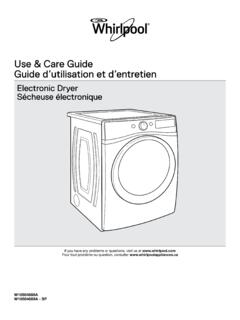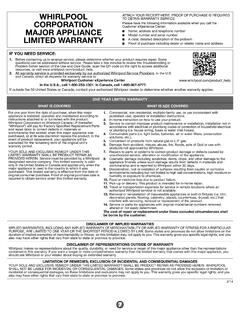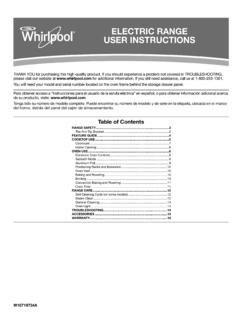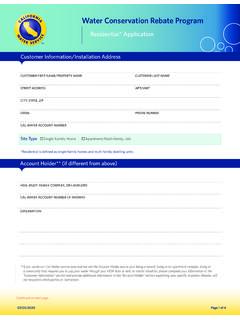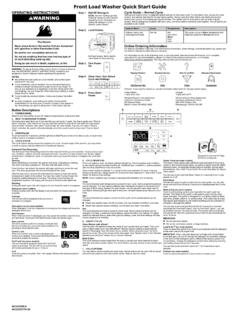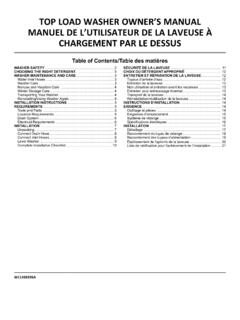Transcription of ONE SPEED AUTOMATIC WASHERS
1 ONE SPEED AUTOMATIC WASHERSUse & Care GuideFor questions about features, operation/performance,parts, accessories or service call: 1-800-253-1301In Canada, for assistance call: 1-800-461-5681, for installation and service call: 1-800-807-6777 or visit our website or Table of 2 TABLE OF CONTENTSWASHER SAFETY .. 3 PARTS AND FEATURES .. 4 washer USE .. 5 Understanding washer Cycles .. washer Sounds ..5 Starting Your washer ..6 Selecting a Cycle and Time ..7 Rinse and Spin ..7 Drain and Liquid Chlorine Bleach ..8 Adding Liquid Fabric Softener ..8 Self-Cleaning Lint Filter ..8 washer CARE .. 8 Cleaning Your washer ..8 Water Inlet Hoses ..8 Vacation, Storage, and Moving 9 ASSISTANCE OR SERVICE .. 11 WARRANTY .. 123 washer SAFETYYou can be killed or seriously injured if you don'timmediately follow can be killed or seriously injured if you don'tfollow safety messages will tell you what the potential hazard is, tell you how to reduce the chance of injury, and tell youwhat canhappen if the instructions are not safety and the safety of others are very have provided many important safety messages in this manual and on your appliance.
2 Always read and obey allsafety is the safety alert symbol alerts you to potential hazards that can kill or hurt you and safety messages will follow the safety alert symbol and either the word DANGER or WARNING. These words mean:IMPORTANT SAFETY INSTRUCTIONS SAVE THESE INSTRUCTIONSn Read all instructions before using the Do not wash articles that have been previously cleaned in, washed in, soaked in, or spotted with gasoline, dry-cleaning solvents, other flammable, or explosive substances as they give off vapors that could ignite or Do not add gasoline, dry-cleaning solvents, or other flammable, or explosive substances to the wash water. These substances give off vapors that could ignite or Under certain conditions, hydrogen gas may be produced in a hot water system that has not been used for 2 weeks or more. HYDROGEN GAS IS EXPLOSIVE. If the hot water system has not been used for such a period, before using the washing machine, turn on all hot water faucets and let the water flow from each for several minutes.
3 This will release any accumulated hydrogen gas. As the gas is flammable, do not smoke or use an open flame during this Do not allow children to play on or in the washer . Close supervision of children is necessary when the washer is used near Before the washer is removed from service or n Do not reach into the washer if the tub or agitator is Do not install or store the washer where it will be exposed to the Do not tamper with Do not repair or replace any part of the washer or attempt any servicing unless specifically recommended in this Use and Care Guide or in published user-repair instructions that you understand and have the skills to carry See Installation Instructions for grounding : To reduce the risk of fire, electric shock, or injury to persons when using the washer , follow basic precautions, including the following:discarded, remove the AND FEATURESThis manual covers several different models.
4 The washer you have purchased may have some or all of the parts and features listed and serial number bOther features your washer may haveLiquid chlorine bleach dispenserMAGIC CLEAN lint filterTemperature selectorLoad size selectorControl panel 5 washer USEU nderstanding washer CyclesWhen the Cycle Control knob is set to a number and pulled out, the washer fills (to the selected load size) before agitation and timing start. The washer begins agitating immediately after filling; agitation occurs with the washer lid up or agitation, the agitator creates a continuous rollover action (on some models) that provides a thorough cleaning of the wash agitation starts, the Cycle Control knob turns clockwise until it points to an OFF area and the cycle : The washer pauses briefly throughout each cycle. These pauses are normal for washer suggestionsFor these suggested full-sized loads, set the LOAD SIZE selector to the highest load size washer SoundsYour new washer may make sounds your old one didn t.
5 Because the sounds might be unfamiliar, you may be concerned about them. These sounds are washingWhen you select a small load size setting, your washer has a lower water level. This can cause a clicking sound from the upper part of the drainIf water is drained quickly from your washer (depending on your installation), you may hear air being pulled through the pump during the end of drain and before spinWhen the cycle changes from draining to spinning, you may hear gears Fill1. Fill2. Wash selected time2. Rinse3. Drain No agitation3. Drain No agitation4. Spin4. Spin-Spray rinse5. Spin The Casual/Permanent Press cycle partially drains, fills, agitates briefly, and OffSUPER CAPACITY WASHERSH eavy Work Clothes3 pair pants3 shirts4 pair jeans 1 coverall1 overallDelicates3 camisoles1 quilted robe4 slips4 panties 2 bras 2 nighties1 baby s dressTowe l s10 bath towels10 hand towels14 wash cloths1 bath matMixed Load3 double sheets4 pillowcases8 T-shirts6 pair shorts 2 shirts2 blouses8 handkerchiefsEXTRA LARGE CAPACITY WASHERSH eavy Work Clothes2 pair pants3 shirts 3 pair jeans1 coverallDelicates3 camisoles4 slips4 panties 2 bras 2 nighties Towe l s8 bath towels8 hand towels10 wash cloths1 bath matMixed Load2 double sheets or1 king size sheet4 pillowcases6 T-shirts 6 pair shorts2 shirts2 blouses6 handkerchiefs6 Starting Your detergent and pour it into the washer .
6 If desired, add powdered or liquid color safe bleach. Add extra detergent for the Super Wash a sorted load of clothes loosely into your washer . nLoad evenly to maintain washer balance. Mix large and small should move easily through the wash water. Overloading can cause poor reduce wrinkling of permanent press clothes and some synthetic knits, use a large load size to provide more space (see step 4).2.(OPTIONAL STEP) Pour measured liquid chlorine bleach into the liquid chlorine bleach dispenser (on some models). Bleach will be diluted automatically during the wash part of the use more than 1 cup (250 mL) for a full load. Use less with a smaller load the manufacturer s directions for safe avoid spilling, use a cup with a pouring spout. Do not let bleach splash, drip, or run down into the washer only liquid chlorine bleach in this : On models without a bleach dispenser, see "Adding Liquid Chlorine Bleach.
7 " the washer the LOAD SIZE selector (on some models) to the correct setting for your wash load and the type of fabric being a load size that allows the load to move freely for best fabric care. See "Loading".nYou may change the load size selection after the washer has started filling by turning the selector to a different the TEMPERATURE selector (on some models) to the correct setting for the type of fabric and soils being washed. Use the warmest water safe for fabric. Follow garment label : On models with temperature selections in the Cycle Control knob, see "Cycle Time and Temperature Options" in the "Selecting A Cycle and Time" : In wash water temperatures colder than 70 F (21 C), detergents do not dissolve well. Soils can be difficult to remove. Some fabrics can retain wear wrinkles and have increased pilling (the formation of small lint-like balls on the surface of garments).
8 Fire HazardNever place items in the washer that are dampened with gasoline or other flammable washer can completely remove not dry anything that has ever had any type of oil on it (including cooking oils).Doing so can result in death, explosion, or Shock HazardPlug into a grounded 3 prong to follow these instructions can result indeath, fire, or electrical not use an extension not use an not remove ground TempUse ForHot111 F (44 C)or aboveWhites and pastelsHeavy and greasy soilsWarm90 -110 F(32 -43 C)Bright colorsModerate to light soilsCold70 -90 F (21 -32 C)Colors that bleed or fadeLight in the Cycle Control knob and turn it clockwise to the wash cycle you want. Reduce the wash time when using a small load size setting. See Selecting a Cycle and Time. Pull out the Cycle Control knob to start the stop or restart your washernTo stop the washer at any time, push in the Cycle Control knob.
9 NTo restart the washer , close the lid (if open) and pull out the Cycle Control (OPTIONAL STEP) If desired, add measured liquid fabric softener to the final rinse water. See Adding Liquid Fabric Softener. Selecting a Cycle and TimeThis section describes the available wash cycles and will help you make the best cycle selections for your wash loads. Each cycle is designed for different types of fabric and soil washer pauses briefly throughout each cycle. These pauses are normal. Refer to Normal washer Sounds to learn more about the sounds you may hear during a wash to Understanding washer Cycles to learn what happens during a wash : This manual covers several different models. The washer you purchased will not have all of the cycles cycleThis cycle features high- SPEED agitation for maximum cleaning, and high- SPEED spin to shorten drying time. Select up to 14 minutes of wash time, depending on your model, to clean large loads of sturdily constructed fabrics that are heavily soiled.
10 For lightly soiled cottons and linens, use the shortest time setting. Super Wash - Select the 18-minute Super Wash feature to wash heavily soiled loads that need maximum soil removal. Use two times the recommended amount of detergent for this cycle. Casual/Permanent Press cycleThis cycle features a cool-down rinse to minimize wrinkling of permanent press blends and synthetic fabrics. Select 6 to 10 minutes of wash time to clean lightly to moderately soiled loads. Gentle cycleThis cycle features a series of brief agitations and soaks, followed by a short spin. Select up to 6 minutes of wash time to gently clean special-care items that are lightly or moderately cycleThis cycle features a series of brief agitations and soaks, followed by a short spin. Use this cycle to clean delicate items and washable knits that are lightly to moderately soiled. Cycle Time and Temperature Options Some models have the water temperature included in the cycle selections of the Cycle Control knob.

